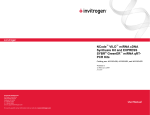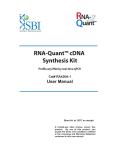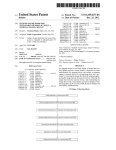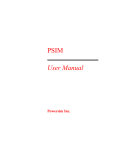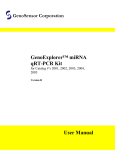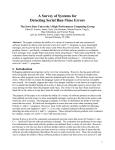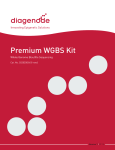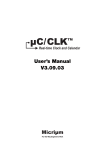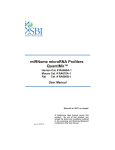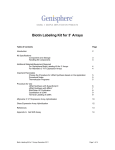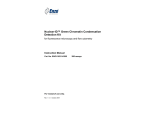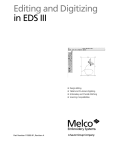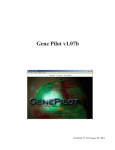Download NCode™ Human miRNA Microarray V3
Transcript
NCode™ Human miRNA Microarray V3 Epoxide-coated glass slides printed with NCode™ miRNA probes Catalog no. MIRAH3-05 Rev. Date: 14 July 2010 Manual part no. A10459 MAN0000692 Corporate Headquarters 5791 Van Allen Way Carlsbad, CA 92008 T: 1 760 603 7200 F: 1 760 602 6500 E: [email protected] For country-specific contact information visit our web site at www.invitrogen.com User Manual ii Table of Contents Kit Contents and Storage .......................................................................... v Additional Products .................................................................................vi Overview..................................................................................................... 1 Microarray Specifications ......................................................................... 6 Alexa Fluor® Dye Control Probes ............................................................ 8 Sample Labeling and Hybridization Guidelines ................................. 10 Scanning and Image Analysis ................................................................ 11 Troubleshooting ....................................................................................... 14 Appendix .................................................................................... 16 Technical Support .................................................................................... 16 Purchaser Notification ............................................................................ 18 Reference................................................................................................... 19 iii iv Kit Contents and Storage Shipping and Storage The NCode™ Human miRNA Microarray V3 is shipped in a desiccated, resealable plastic storage container at room temperature. Upon receipt, store the microarray slides in the storage container at room temperature protected from light. Contents Each box contains five microarray glass slides, blocked and ready to use. v Additional Products Additional Products The NCode™ Human miRNA Microarray V3 is part of an integrated microRNA expression profiling system that includes isolation, labeling, and array hybridization components. Additional products are available separately from Invitrogen. Ordering information is provided below. For more information, visit our website at www.invitrogen.com\ncode or contact Technical Support (page 16). Product Quantity Catalog no. NCode™ Rapid miRNA Labeling System 20 reactions MIRLSRPD-20 NCode™ miRNA Amplification System 20 reactions MIRAS-20 NCode™ Multi-Species miRNA Microarray Control V2 10 μl MIRAC2-01 NCode ™ Human miRNA Microarray Probe Set V3 Contact Invitrogen Technical Support to order (see page 16) NCode ™ Multi-Species miRNA Microarray Probe Set V2 3 × 384-well plates / 500 pmol per well MIRMPS2-01 NCode™ SYBR® Green miRNA qRT-PCR Kit NCode™ SYBR® GreenER™ miRNA qRT-PCR Kit 10 polyadenylation/ 20 cDNA synthesis/ 100 qPCR reactions MIRQER-100 NCode™ miRNA FirstStrand cDNA Synthesis Kit 10 polyadenylation/ 20 cDNA synthesis 50 polyadenylation/ 100 cDNA synthesis MIRC-10 MIRC-50 UltraPure™ 20X SSC 1 liter 4 liters 15557-044 Quant-iT™ Ribogreen® RNA Assay Kit 200–2,000 cuvette assays R-11490 RediPlate™ 96 Ribogreen® RNA Quantitation Kit 96-well plate (8 × 12 strip wells) R-32700 vi Overview Introduction The NCode™ Human miRNA Microarray V3 is supplied as a kit of five Corning® Epoxide-Coated Glass Slides, each printed with optimized probe sequences targeting all of the known mature human miRNAs in the miRBase Sequence Database, Release 10.0 (http://microrna.sanger.ac.uk), as well as novel human miRNAs discovered through deep sequencing and validated by qRT-PCR and array profiling. You can use each microarray to screen dye-labeled human miRNA samples. Each microarray slide comes fully blocked and ready to use. Experimental Outline— Labeling and Microarray Hybridization 5´ The NCode™ Human miRNA Microarray V3 has been designed and developed as part of a comprehensive suite of NCode™ products for miRNA labeling, detection, and analysis. The figure below shows labeling and array hybridization using the NCode™ Rapid miRNA Labeling System: RNA molecule 3´ Poly(A) tailing reaction Alexa Fluor® dye 5´ 3´ Ligation of DNA polymer with ~15 dye molecules Oligo(dT) bridge Array hybridization Continued on next page 1 Overview, continued MicroRNAs MicroRNAs (miRNAs) are a recently discovered class of small, ~19–23-nucleotide non-coding RNA molecules. They are cleaved from 70–110-nucleotide hairpin precursors and are believed play an important role in translation regulation and degradation of target mRNAs by binding to partially complementary sites in the 3´ untranslated regions (UTRs) of the message (Lim, 2003). Recent experimental evidence suggests that the number of unique miRNAs in humans could exceed 800, though several groups have hypothesized that there may be up to 20,000 non-coding RNAs that contribute to eukaryotic complexity (Bentwich et al., 2005; Imanishi et al., 2004; Okazaki et al., 2002). Though hundreds of miRNAs have been discovered in a variety of organisms, little is known about their cellular function. They have been implicated in regulation of developmental timing and pattern formation (LagosQuintana et al., 2001), restriction of differentiation potential (Nakahara & Carthew, 2004), regulation of insulin secretion (Stark et al., 2003), and genomic rearrangements (John et al., 2004). Several unique physical attributes of miRNAs—including their small size, lack of poly-adenylated tails, and tendency to bind their mRNA targets with imperfect sequence homology—have made them elusive and challenging to study. In addition, strong conservation between miRNA family members means that any detection technology must be able to distinguish between ~22-base sequences that differ by only 1–2 nucleotides. Recent advances in spotted oligonucleotide microarray labeling and detection have enabled the use of this high-throughput technology for miRNA screening. Continued on next page 2 Overview, continued Advantages of the Microarray Other Products in the NCode™ System The NCode™ Human miRNA Microarray V3 has the following advantages: • Offers more human miRNA probe content than any other commercially available microarray, including novel content • Probes are designed for uniform hybridization and maximum specificity, to distinguish between closely related miRNAs • Includes positive control probes for hybridization validation using the NCode™ Multi-Species miRNA Microarray Control V2 • Includes Alexa Fluor® Dye Control Probes for easy normalization of signal intensities during scanning • Includes mismatch controls for screening 1- and 2-base sequence mismatches • Microarray is provided blocked and ready to use • Designed and developed as part of the comprehensive NCode™ system The following products are available separately from Invitrogen (for ordering information, see page vi): • The NCode™ Rapid miRNA Labeling System is a robust and efficient system for labeling RNA samples and hybridizing the labeled miRNA to NCode™ microarrays for expression profiling analysis. Using this kit, you ligate a DNA polymer labeled with highly fluorescent Alexa Fluor® dye molecules to a total RNA sample, and then hybridize the labeled miRNA in the sample to an array. The system is designed to ensure maximum signal and strong signal correlations. • The NCode™ miRNA Amplification System is a robust system for amplifying sense RNA molecules from minute quantities (<30 ng) of miRNA. The system provides consistent and accurate ≥1000-fold amplification while preserving the relative abundance of the miRNA sequences in the original sample, allowing you to compare relative quantities across experiments. List continued on next page Continued on next page 3 Overview, continued Other Products in the NCode™ System, continued List continued from previous page • NCode™ Profiler is a free downloadable Windowsbased software program for designing and analyzing two-dye expression profiling microarray experiments. NCode™ Profiler can be used to design loop-design and dye-swap experiments and analyze the results. A link to the software download page can be found at www.invitrogen.com/ncode (click on miRNA Data Analysis). • The NCode™ Multi-Species miRNA Microarray Control V2 is a synthetic 22-nucleotide miRNA sequence that has been designed and screened as a positive control for use with NCode™ system. This control sequence has been tested for cross-reactivity with endogenous miRNAs from model organisms, and is provided at a concentration compatible with endogenous miRNA expression levels. • The NCode™ Multi-Species miRNA Microarray V2 includes all known mature miRNAs in the miRBase Sequence Database, Release 9.0, for human, mouse, rat, D. melanogaster, C. elegans, and Zebrafish. • The NCode™ SYBR® Green miRNA qRT-PCR Kit provides qualified reagents for the detection and quantitation of miRNAs in quantitative RT-PCR (qRTPCR). This kit has been optimized for the detection and quantification of miRNA from 10 ng to 2.5 μg of total RNA using a SYBR® Green detection platform. • The NCode™ SYBR® GreenER™ miRNA qRT-PCR Kit provides qualified reagents for the detection and quantitation of miRNAs in real-time qRT-PCR. This kit has been optimized for the detection and quantification of miRNA from 10 ng to 2.5 μg of total RNA using a SYBR® GreenER™ detection platform. • The NCode™ miRNA First-Strand cDNA Synthesis Kit provides qualified reagents for the polyadenylation of miRNAs from total RNA and synthesis of first-strand cDNA from the tailed miRNAs for use in real-time quantitative PCR (qPCR). SYBR® Green or SYBR® GreenER™ reagents may be purchased separately. Continued on next page 4 Overview, continued NCode™ System Workflow Microarray GAL File The NCode™ Human miRNA Microarray V3 has an associated GAL (GenePix® Array List) file that lists the identities and locations of all the probes printed on the array. This GAL file is available on the Invitrogen web site or can be requested from Invitrogen Technical Support (see page 16). On the web site, follow the link from the V3 microarray product page in the online catalog, or perform a simple search for “V3 GAL file” using the Search box. See page 12 for more information. 5 Microarray Specifications Probe Design The oligonucleotide probes printed on the NCode™ Human miRNA Microarray V3 were designed from human miRNA sequences from the Sanger Institute’s mirBase Sequence Database, Release 10.0 (http://microrna.sanger.ac.uk), as well as from novel human miRNAs discovered through deep sequencing and validated by qRT-PCR and array profiling. In addition, mismatch probe sequences and probes complementary to the NCode™ Multi-Species miRNA Microarray Control V2 are printed throughout the array. Probes were designed using a proprietary algorithm that generates miRNA sequences with enhanced hybridization properties (Goff et al., 2005). The probes on the NCode™ microarray provide comparable sensitivity to wild-type sequences, while offering maximum specificity for discerning between closely related miRNAs and normalized melting temperatures for uniform hybridization. Probes have been validated for their ability to distinguish between wild-type and mismatched miRNA sequences with ≥1 base mismatch. Microarray Printing Specifications The NCode™ Human miRNA Microarray V3 is contactprinted using microquill pins on Corning® Epoxide-Coated Glass Slides. The array specifications are: Total subarrays per slide: 3 Subarray layout: 8 blocks (4 rows × 2 columns) Block layout: 192 spots (12 rows × 16 columns) Block dimensions: 4 mm × 3 mm Spot center-to-center spacing: 265 μm Probes: Unmodified oligonucleotides, 34–44 bases long Microarray Blocking Unprinted areas of each NCode™ Human miRNA Microarray V3 are fully blocked by the array manufacturer to reduce background fluorescence. No additional blocking steps are necessary. Continued on next page 6 Microarray Specifications, continued V3 Microarray Layout The NCode™ Human miRNA Microarray V3 is laid out as three replicate subarrays, as shown in the illustration below. Consult the GAL file for the layout of the spots in each subarray (see page 5 for download information). Note: The array is printed on the same side of the slide as the barcode. Probe Type Human from mirBase Database, Release 10.0 Invitrogen Novel Human miRs Small nucleolar RNAs NCode™ Control Mismatch controls Alexa Fluor® Dye Controls Dye markers Subarray 1 Replicate 1 of 3 Subarray 2 Replicate 2 of 3 Subarray 3 Replicate 3 of 3 Number of Probes/Subarray 710 373 29 24 76 10 8 1234567 Subarray Image The image below is of a single subarray. 7 Alexa Fluor® Dye Control Probes Description and Location The Alexa Fluor® Dye Control Probes printed on the array are designed to bind directly to the NCode™ Dye Normalization Control provided with the NCode™ Rapid miRNA Labeling System. These controls are printed as a row of five spots, in duplicate on each subarray (one row in the bottom of Block 1, the other row in the bottom of Block 8—see diagram below). The five controls are printed in a range of concentrations, from high to low, to allow for normalization of differences in fluorescent signal intensities between the two capture reagents. Subarray 1 Highest intensity 2 3 4 5 Subarray 3 Subarray 2 1 Lowest intensity Position of Controls The image below shows a typical pattern of control spots in a block. Dye marker ™ NCode Controls ® Alexa Fluor Dye Controls Continued on next page 8 Alexa Fluor® Dye Controls, continued Using the Alexa Fluor® Dye Control Probes Following array hybridization as described in the NCode™ Rapid miRNA Labeling System manual, scan the microarray at the scanner’s recommended settings. After the scan, focus on each row of Alexa Fluor® Dye Controls in each subarray and determine the signal intensity of each control spot in one or both dye channels. For signal intensity normalization: • Dye Control Spot 1 (the most concentrated control)— should have a saturated signal • Dye Control Spot 5 (the least concentrated control)— should be detectable • Dye Control Spots 2–4—at least one of these should have a signal intensity within the linear range of the scanner (1,000–40,000 RFUs). For single-color array hybridizations: Adjust the scanning settings and rescan as necessary to ensure that the signal intensity guidelines above are met. For dual-color array hybridizations: Adjust the scanning settings in each channel and rescan as necessary to ensure that (1) the above guidelines are met and (2) the ratio of signal intensities between both channels for Dye Control Spots 2–4 are as close to one another as possible. Important: Use only those control spots for which neither channel is saturated. 9 Sample Labeling and Hybridization Guidelines Introduction NCode™ Rapid miRNA Labeling System This section provides guidelines for hybridizing fluorescently labeled miRNA samples to the microarray. • Always wear powder-free latex gloves when handling microarrays. • Avoid contact with the printed array surface. The array surface should remain as lint-free and dust-free as possible. • Open the slide container just prior to use, and close immediately to store unused slides. • NCode™ miRNA microarray products are designed for coverslip hybridizations with volumes of 80 μl or less. This microarray has been developed and validated using the NCode™ Rapid miRNA Labeling System for fluorescent labeling and hybridization of miRNA samples (see page vi for ordering information). We strongly recommend using this system. The NCode™ Rapid miRNA Labeling System provides reagents that have been specifically optimized for use with this microarray, including reagents for labeling RNA samples with Alexa Fluor® dyes and wash and hybridization buffers.* See the manual supplied with the NCode™ Rapid miRNA Labeling System for detailed labeling and hybridization instructions. *The Rapid Ligation Mixes included with the Labeling System contain 3DNA™ reagent manufactured under license from Genisphere, Inc. Important 10 If you are labeling and hybridizing samples using a method other than the NCode™ Rapid miRNA Labeling System, note that the wash and hybridization reagents must be compatible with Corning® Epoxide-Coated Glass Slides. Scanning and Image Analysis Introduction After the final array hybridization and wash, the array should be scanned immediately. Materials Needed To scan the array, you will need the following: Important Array Orientation • A standard digital microarray scanner. We recommend a scanner with a bit depth of at least 16 bits/pixel. The GenePix® 4000B (Molecular Devices) has been tested with NCode® microarrays, and includes GenePix® software for analyzing the scanned image. • Microarray acquisition and analysis software, such as GenePix® Pro (Molecular Devices) or ScanArray® Express (PerkinElmer, Inc.). The array should be shielded from direct light and scanned within ½ hour of completing the final wash, to minimize photobleaching of the fluorescent labels. Be careful to position the array slide in the proper orientation in the microarray scanner. If no signal is apparent after scanning, double-check the orientation of the slide. Consult your scanner documentation for details. Note that each block in the array has a dye marker (or “landing light”) in the upper left corner that typically appears greener than other spots on the array, to enable proper orientation of the slide in the scanner. Scanning Guidelines • Program your microarray scanner for the excitation and emission maxima of the labeling dyes you are using. If you are using the NCode™ Rapid miRNA Labeling System, note that Alexa Fluor® 3 and 5 have excitation and emission maxima identical to Alexa Fluor® 546 and 647, respectively. See the NCode™ Rapid miRNA Labeling System manual for details. Guidelines are continued on the next page Continued on next page 11 Scanning and Image Analysis, continued Scanning Guidelines, continued Guidelines continued from the previous page • • • Follow the instructions provided with your scanner to adjust the photomultiplier tube (PMT) settings. It is important to adjust the PMT setting for each channel, for maximum dynamic range and channel balance. A typical lower limit of detection (LLD) is 8 times the median local background of all array features. The signal/background (S/B) ratio is calculated by dividing the median signal of positive features by the median background. When scanning dual-color arrays, we recommend examining the image histogram (available with GenePix® Pro software) to determine whether the signal intensities in the two channels are comparable. GAL File The GAL (GenePix® Array List) file for the array is a tabdelimited text file that contains the positions, names, and probe ID’s of the probes on the NCode™ microarray, in tabular format. Most major microarray software applications, including GenePix® Pro and ScanArray®, can combine the information from the GAL file with the data from the scanned array to generate a results file with all the data for the experiment. Note: If your software does not accept files in GAL format, open the file in a spreadsheet program like Microsoft® Excel and reformat the information in a compatible configuration, or manually correlate information with your spot intensity data. Consult your microarray analysis software for details. Downloading the GAL Files The GAL file is available on the Invitrogen web site or can be requested from Invitrogen Technical Support (see page 16). On the web site, follow the link from the NCode™ Human miRNA Microarray V3 product page in the online catalog, or perform a simple search for “V3 GAL file” using the Search box. Click on the link to open the GAL file or save it to a location on your computer. Then follow the instructions provided with your microarray analysis software to combine the GAL file information with your scan data. Continued on next page 12 Scanning and Image Analysis, continued GAL File Terminology The GAL file includes the following identifiers: • • • • • • NCode™ Profiler Blank : Buffer-only control Dye marker : Used to align the array in the scanner (a.k.a. “landing light”) Mut1 : Probe with a single-base mismatch for the corresponding miR Mut2 : Probe with a two-base mismatch for the corresponding miR Rev : Probe with the reverse sequence for the corresponding miR Shuf : Probe with a shuffled sequence for the corresponding miR NCode™ Profiler is a free downloadable Windows-based software program for designing and analyzing two-color expression profiling microarray experiments. NCode™ Profiler can be used to design loop-design or dye-swap experiments, and the resulting data file(s) can then be imported back into Profiler for analysis. A link to the software download page can be found at www.invitrogen.com/ncode (click on miRNA Data Analysis). Probe Information Complete probe information, including sequences, is available in the NCode™ miRNA Database, at http://rnaidesigner.invitrogen.com/ncode. 13 Troubleshooting Problem Cause Coverslip stuck to array surface Hybridization chamber not properly sealed or humidified Low or no overall fluorescent signal intensity on the array Solution Make sure that the hybridization chamber is properly sealed with the correct amount of liquid prior to incubation of the hybridized array Inadequate volume of hybridization buffer used for coverslip size Make sure that the hybridization buffer completely covers the array surface under the coverslip. Photobleaching of the fluorescent labels Avoid direct exposure of the hybridized array and the mixes containing the fluorescent dyes to light. Perform all hybridization and wash procedures in low light conditions. Incubation temperatures during hybridization were incorrect Incubation temperatures that are too high will result in lower signal. Check the temperatures of all incubators with a calibrated thermometer. Degraded starting material Use isolated small RNA as starting material for labeling and hybridization, and follow appropriate guidelines for handling RNA to prevent RNase contamination. Always use fresh samples or samples frozen at -80°C. If you are starting with total RNA, analyze it by agarose/ethidium bromide gel electrophoresis prior to isolation of small RNA. Array slide scanned in wrong orientation Check the position of the slide in the scanner; reposition and rescan if necessary Continued on next page 14 Troubleshooting, continued Problem Cause Solution High or uneven background on the array Wash solution residue on the slide Transfer the slide quickly between wash steps, and centrifuge immediately after the final wash step to quickly dry the slide. Avoid exposing the slide to air between washes for more than a few seconds. Improperly dried wash solution will appear as streaks on the slide. Dehydration of the hybridization buffer This frequently appears as high background around the edges of the array coverslip. Make sure that the hybridization buffer completely covers the array surface under the coverslip, and that humidity is maintained during incubation. Improper array handling Always wear powder-free gloves when handling the array, and avoid touching the slide surface. Scanner laser and/or PMT settings are too high Increasing these settings to adjust for low signal will increase array background. If the fluorescent signal is too low, see the troubleshooting on the previous page. 15 Appendix Technical Support Web Resources Contact Us Visit the Invitrogen website at www.invitrogen.com for: • Technical resources, including manuals, vector maps and sequences, application notes, SDSs, FAQs, formulations, citations, handbooks, etc. • Complete technical support contact information • Access to the Invitrogen Online Catalog • Additional product information and special offers For more information or technical assistance, call, write, fax, or email. Additional international offices are listed on our website (www.invitrogen.com). Corporate Headquarters: 5791 Van Allen Way Carlsbad, CA 92008 USA Tel: 1 760 603 7200 Tel (Toll Free): 1 800 955 6288 Fax: 1 760 602 6500 E-mail: [email protected] Japanese Headquarters: LOOP-X Bldg. 6F 3-9-15, Kaigan Minato-ku, Tokyo 108-0022 Tel: 81 3 5730 6509 Fax: 81 3 5730 6519 E-mail: [email protected] European Headquarters: Inchinnan Business Park 3 Fountain Drive Paisley PA4 9RF, UK Tel: +44 (0) 141 814 6100 Tech Fax: +44 (0) 141 814 6117 E-mail: [email protected] SDS Safety Data Sheets (SDSs) are available on our website at www.invitrogen.com/sds. Certificate of Analysis The Certificate of Analysis provides detailed quality control and product qualification information for each product. Certificates of Analysis are available on our website. Go to www.invitrogen.com/support and search for the Certificate of Analysis by product lot number, which is printed on the box. Continued on next page 16 Technical Support, continued Limited Warranty Invitrogen (a part of Life Technologies Corporation) is committed to providing our customers with high-quality goods and services. Our goal is to ensure that every customer is 100% satisfied with our products and our service. If you should have any questions or concerns about an Invitrogen product or service, contact our Technical Support Representatives. All Invitrogen products are warranted to perform according to specifications stated on the certificate of analysis. The Company will replace, free of charge, any product that does not meet those specifications. This warranty limits the Company’s liability to only the price of the product. No warranty is granted for products beyond their listed expiration date. No warranty is applicable unless all product components are stored in accordance with instructions. The Company reserves the right to select the method(s) used to analyze a product unless the Company agrees to a specified method in writing prior to acceptance of the order. Invitrogen makes every effort to ensure the accuracy of its publications, but realizes that the occasional typographical or other error is inevitable. Therefore the Company makes no warranty of any kind regarding the contents of any publications or documentation. If you discover an error in any of our publications, report it to our Technical Support Representatives. Life Technologies Corporation shall have no responsibility or liability for any special, incidental, indirect or consequential loss or damage whatsoever. The above limited warranty is sole and exclusive. No other warranty is made, whether expressed or implied, including any warranty of merchantability or fitness for a particular purpose. 17 Purchaser Notification Introduction This product is covered by one or more Limited Use Label Licenses as set forth below. For a list of additional Limited Use Label Licenses applicable to this product, please visit our website at www.invitrogen.com. By the use of this product you accept the terms and conditions of all applicable Limited Use Label Licenses. Limited Use Label License No. 279: DNA Microarrays This product and its use are covered by one or more of the following patents owned by Oxford Gene Technology Limited or Oxford Gene Technology IP Limited: US 5,700,637, and pending patents. The purchaser is licensed to practice methods and processes covered by these patents using this product for its own internal research purposes only but may not: transfer data derived from the use of this product to third parties for value; use this product in the provision of services to third parties for value; use this product to make, have made, create or contribute to the creation of stand alone expression database products for license, sale or other transfer to a third party for value; or use this product for the identification of antisense reagents or the empirical design of probes or sets of probes for using or making nucleic acid arrays. Limited Use Label License No. 281: DNA Microarrays – Affy Limited License: This product, and/or components of this product, are licensed by Affymetrix under certain patents owned or controlled by Affymetrix. This product is licensed for research use only, and is not for use in diagnostic procedures. This limited license permits only the use of this product for your internal research purposes. No other right, express or implied, is conveyed by the sale of this product. In particular, no right to make, have made, offer to sell, or sell this product is implied by the sale or purchase of this product. No right to make, have made, use, import, offer to sell, or sell any other product in which Affymetrix has patent rights is implied by the sale or purchase of this product. The purchase of this product does not by itself convey or imply the right to use such product in combination with any other product(s). This product is licensed for single use only. The purchaser or user of this product should contact Affymetrix ([email protected]) to determine the availability of a separate license for other products or processes subject to Affymetrix patents. Trademarks of Other Companies 3DNA™ is a trademark of Genisphere, Inc. Corning® is a registered trademark of Dow Corning Corporation. ScanArray® is a registered trademark of PerkinElmer, Inc. GenePix® is a registered trademark of Molecular Devices Corporation. 18 Reference Goff, L. A., Yang, M., Bowers, J., Getts, R. C., Padgett, R. W., and Hart, R. P. (2005) Rational probe optimization and enhanced detection strategy for microRNAs using microarrays. RNA Biology, 2, published online ©2010 Life Technologies Corporation. All rights reserved. For research use only. Not intended for any animal or human therapeutic or diagnostic use. The trademarks mentioned herein are the property of Life Technologies Corporation or their respective owners. 19 Notes 20 Corporate Headquarters 5791 Van Allen Way Carlsbad, CA 92008 T: 1 760 603 7200 F: 1 760 602 6500 E: [email protected] For country-specific contact information visit our web site at www.invitrogen.com User Manual




























